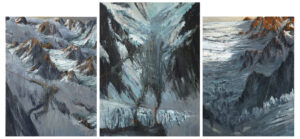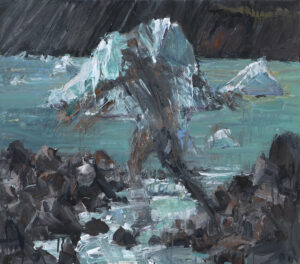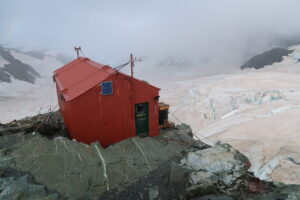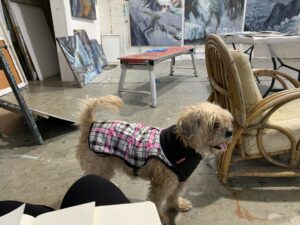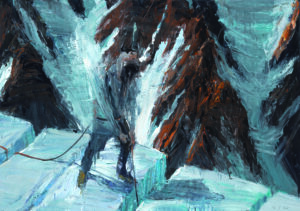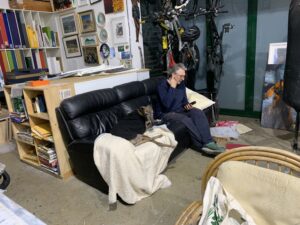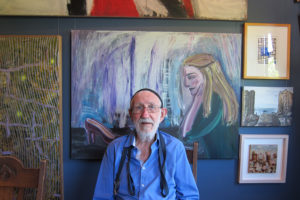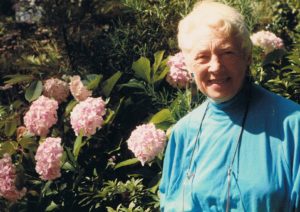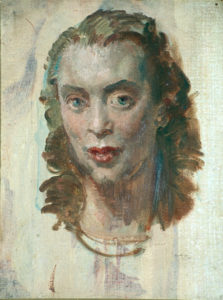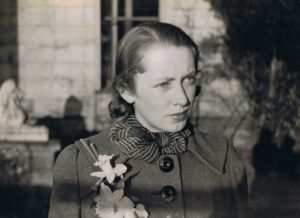Elizabeth Fortescue
Elizabeth Fortescue is the visual arts writer for the Daily Telegraph, Sydney, and Australian correspondent for The Art Newspaper, London
Homepage: http://www.artwriter.com.au
Posts by Elizabeth Fortescue
Australian artists based in Kyiv during the Russian invasion
Mar 24th
The Australian artists George Gittoes and Hellen Rose left for Ukraine last Friday (18 March) and are now in the capital city, Kyiv.
As the whole world knows, Kyiv is under siege by Russian forces who have been ordered in by Vladimir Putin.
I spoke to George Gittoes the day before he and his wife Hellen left their home in Werri Beach on the NSW south coast.
Here is the edited interview.
“The plan is to catch a train into Kyiv. The train line is still running. Hopefully it will still be running when we get there. They’re using antiquated, pre-digital communication systems so the Russians can’t predict what they’re doing. And then we plan to spend at least a month in Kyiv.
“I’m taking four movie cameras with me. I’m hoping to create a little Yellow House situation where I’ve got artists and young filmmakers and stuff that we can help. We can employ them and also be doing things together. And I’m planning to do a big peace mural on one of the walls in the city. A mural attracts creative people from everywhere and lets everyone know you’re an artist.
“We’ve heard about a young woman who wants to meet us who was the top prima ballerina in Kyiv and she’s now picked up a gun and she’s fighting the Russians. But they’re the kind of stories, like I’ve always done, where we find people who believe in art not war. How creative people kind of face off against the destroyers. I think that’s particularly interesting in this case because we’re dealing with a very civilised country. It’s famous for its universities. What I’ve learnt is when you go to a place like that and you’re under attack and someone turns up who’s offering to create new things, it’s just impactful. It’s like creating in the face of destruction. It inspires people. I’m sure by the time we leave there we’ll have a network as big as the one in Afghanistan.
“We kind of represent Australia as a country that cares and people see the art and film we make, we symbolise the caring nature of people. Most Australians would love to be able to do things like us, but they don’t know how to. Hellen and I have got no excuse because we know how to.”
So you almost feel you have to go and do what you’re doing?
“Yes, if I didn’t do this I wouldn’t forgive myself because we know that we can do so much good.
“The thing that’s fascinating to me about this war is we’ve got an artist leading the country. Zelensky is an artist. He’s a communicator. We’ve been talking to people close to him, and we’ll probably meet him when we get there. I know we’ll relate well to him. And they’re saying, ‘George we need you and your cameras and your communication skills more than anything, because our biggest fear is that the world will lose interest’.
Have you ever been to Ukraine before?
No. That’s what makes this very hard. I’m at a stage of my life now where everywhere is easy for me to go. If I go to Cambodia I know everyone there. If I go to Baghdad, Nicaragua, Western Sahara, Palestine, Iraq, all these places I’ve got a network of people who’ll meet me at the airport and show me love and everything is actually easy. South Side Chicago. It’s like going home to all these places. So this is the first time in decades where I’ve gone to a conflict zone where I haven’t got the comfort of a network. I have to create a network and that’s a challenge.
You’ll base yourselves in Kyiv at least a month. Is one of your aims to make a film about Ukraine?
Well, we’ve already got this model of the Yellow House so I want to help a whole lot of young filmmakers and people who want to make film, because when you go into one of these war zones, the thing that everyone wants is for the world to know what they’re going through, for their story to be told. So when we leave, maybe I’ll leave all my cameras there. There’s going to be a lot of people like you, who would never dream of picking up a gun, and who are. I think that’s my film. That dilemma of being a pacifist, but there’s a point where pacificists realise there’s something they have to fight for.”
Elizabeth Fortescue, 24 March 2022
Euan Macleod’s Figure in a Dissolving Landscape: a studio interview
Sep 19th
I was walking my dogs to the dog park a couple of months ago when I saw Euan Macleod and Susan Jarvis coming towards me along the path. I love the way Euan walks along with his shoulders a little stooped and his head in the clouds, a bit like a man from one of his paintings, lost in thought.
We stopped to chat and catch up and of course the talk turned to the coronavirus and how it had radically changed everyone’s lives. Euan volunteered that lots of people had been asking him if the pandemic had found its way into his work. Had it inspired him? Had it driven him into his studio? It absolutely hasn’t, he told me. He confessed that, like many of his artist friends, he’d found the pandemic paralysing rather than galvanising.
It would be wrong to say, however, that Euan hasn’t been working hard during these difficult months. With painting excursions cancelled because of travel restrictions, and boozy gallery openings not happening, he has turned to his studio in a sustained effort of painting. His inspiration was a trip earlier this year to the wilds of a New Zealand glacial landscape where he spent three nights in a tiny hut perched above a vast expanse of white. A helicopter dropped Euan into the remote wilderness with a few light painting materials, the New Zealand photographer Craig Potton and a guide who brought all the food. They were equipped to stay for longer, but were forced to leave early by oncoming bad weather.
After the trip, Euan locked himself inside his studio at home, and painted and painted. The resulting artworks are now on view at King Street Gallery on William, in East Sydney, where Euan is having his first exhibition after 40 years in the artist-family of the recently-closed Watters Gallery. The new exhibition, Figure in a Dissolving Landscape, is on until September 26.
When I ran into Euan and Susan that day on the path to the dog park, they asked me to come over and have coffee. With Euan’s exhibition a good excuse for a conversation, I went over on August 3 with my dogs Tibbie and Jade (who quickly made themselves at home in Euan’s studio), and recorded the following interview.
You and New Zealand writer Lloyd Jones have produced a new book called High Wire. How did the theme of bridges come about?
It was Lloyd’s suggestion and it was kind of nice because I had been doing bridge paintings. That’s one of those symbols, I love the idea or analogy of going to one place or another, or bridging gaps, and that kind of idea. And he drew the analogy between New Zealand and Australia and that link between them.
You recently went to Mount Cook in New Zealand on a painting trip? Had you been there before?
Yeah, I used to go climbing when I was young. It’s that volcanic thing, that idea of what’s going on under the surface that I really, really love. And so when I got back I did these little works on paper. I did hundreds of these. And these potentially [and did] become paintings.
We were looking down at all these glaciers around us. It was bloody scary. As long as you didn’t do anything stupid there was nothing wrong but the main problem was you’re just in this environment which is falling apart. You’re in an environment that’s so fragile and so extremely vulnerable. You’re in an environment that’s incredibly beautiful but you feel vulnerable. You feel almost invisible. You shouldn’t really be there. That’s an aspect I was trying to get across, our vulnerability – and the world, really.
Tell me about Lloyd Jones.
His writing has a lovely visual sense to it. He set out this idea of doing an art book for adults, like a picture book for adults. But the big thing was he changed it from bridges to high wires. To a certain extent it was based on Philippe Petit [the skywalker who stunned New York in 1974 when he nonchalantly walked between the Twin Towers on a high wire]. I didn’t read a lot of what [Jones] wrote until afterwards [not wanting to be influenced before he produced his own work in response to the theme]. But he would make suggestions and it was a collaboration. He loved the idea of people looking up.
Had you tackled the subject of bridges and high wires before?
Not high wires so much but definitely bridges. I’ve done this thing with the rope, and the rope’s a connection. And it’s a bit like a highwire too, it’s a similar kind of thing, trusting in the rope. So it felt right.
[Euan said he wanted the big figure in the middle of his big triptych, Figure in a Dissolving Landscape, to be “dwarfed” by the landscape.] And how do you do that? How do you suggest this massive, massive landscape that’s enveloping the person, without having them tiny? And one way you can do that is you have the figure in the air or in the middle, so I did a lot with people standing in clouds and on clouds, and I thought, well, the highwire is the perfect way because it’s a person suspended in the middle of nothing.
The man in middle panel of the triptych appears to be standing on a precipice.
Mm, I’m glad you can see that. See I know it is, but … that to me, that was like that. The hut was absolutely on a precipice and they’re put there on purpose because the main danger of these huts is rock fall, rocks falling on top of them, so they have to be on rock.
How was the hut?
It’s pretty spartan but not bad, and we were the only ones there, thank God.
Freezing cold?
No, it wasn’t too bad.
Did you walk out to see the stars?
Oh yeah, it was all pretty beautiful. The guys got up really early one morning to see the sun come up and I’ve got to say I just went no, fuck you, I want my sleep. Isn’t that terrible!
[Euan said he wanted to paint the “thrill” of being in that landscape.]
The sublime.
Yeah, the Caspar David Friedrich thing. An absolute total influence. All those guys used to do their pilgrimage to the Alps and things, so it’s not that dissimilar, really.
You get the sense in these paintings that you’re a long way from civilisation and human comforts.
Yeah. I don’t do the climbing stuff any more so it’s not dangerous, but you are in an environment if anything goes wrong you’re a long way from any kind of help or support or anything.
When were you a climber? In your 20s and 30s?
No, younger. And I wasn’t a very good one. I was pretty crappy at it, because it’s one of those things you have to be pretty committed and you also have to be pretty fearless, and I’m not. I wasn’t fearless and I wasn’t committed really. I loved it, and what I loved about it was being in that environment. The thing about climbing mountains, there was a thrill in that, but just being in that environment was just so amazing. You want to be in more and more extreme environments, and you need those skills to help you. But having the guide there was a real bonus and they supplied all the equipment which was just brilliant too.
When you were there on the mountain, you could work?
Yes, I worked on the acrylics and a few drawings. So the middle panel [of the triptych], that has developed from one of those drawings that I did up there. Just the sense of seeing this ice fall, how the ice fell off the mountain and down into the glacier, it was just spectacular. I’m so pleased I can show you that [the triptych] because I only finished it on Friday.
It’s that sense of being helpless, you’re so tiny in nature. But you’re also not. We’re destroying that landscape, you know, that humanity, well global warming has been terribly, you know, Mount Cook has had a great big huge chunk fall off it and it’s receding all the time. The Tasman Glacier, when I was about 19 when I went up, I walked all the way up. There’s no way you could do that now. It’s so broken up and receded so far. There wasn’t a lake at the end of it when I went up then. Now there’s this massive lake that jet boats go around on and take tourists on. And that’s in, what, 40 years? You look at it and you think, we’re buggering it up.
At least COVID is keeping lots of planes out of the sky for the moment.
I do probably need to sit in one place and digest where I’ve gone rather than just go flying around. We were going to be going to Greece and Crete in September which would have been great, but I’m enjoying doing this [his current work based on the Mount Cook trip]. That’s the thing, you go on one of those trips and your focus gets shifted and you sometimes, I mean I don’t know where this will lead to. You never know where they’ll go.
Elizabeth Fortescue, September 19, 2020

Noel McKenna: a dive into the archives as the artist’s new show starts
Jul 24th
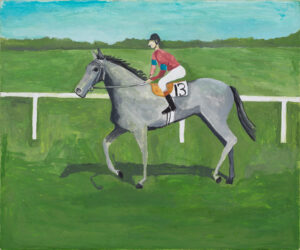
Australian Thoroughbred, by Noel McKenna, 2020
Having noticed that the wonderful Noel McKenna is having a new exhibition (The night is doubtful, Darren Knight Gallery, Sydney, 25 July to 22 August, 2020), I thought I would dig into my archive and pull out my 2016 interview with Noel about the exhibition he was about to have back then. In that show, Noel was to exhibit his “August 1 series” of annual horse paintings. For non-horsey readers, August 1 is traditionally the horses’ birthday. Noel knows that, because he adores horses. Every August 1, Noel paints another picture of a horse and thus adds to the series he has been doing for many years.
I thought it would be appropriate to interview Noel among the equines at Randwick Racecourse. So, with the help of my friend Ray Thomas, the Daily Telegraph’s chief racing writer, Ron Quinton agreed to have Noel, me and photographer Chris Pavlich at his stables one morning after track work. Again, for the non-horsey, I must explain that Ron is a legend of the Australian racing game and recognised everywhere as a delightful man.
The day of the interview dawned, and on arrival at Randwick Racecourse the first thing I did was fall flat on my face on a grassy hill just behind Ron’s stables. Chris Pavlich picked up the pieces and dusted me off before we made our appearance.
Here is a link to the story, with Chris’s beautiful pictures, that ran in the paper a few days later. https://www.dailytelegraph.com.au/entertainment/arts/artist-noel-mckenna-celebrates-the-official-horses-birthday-by-adding-to-a-series-he-began-in-1992/news-story/4b734fb578213c3092bc68a2f6d5397f
Now Noel has told me that, much as he loves horses, he is actually a bit nervous of being too close to them. But Ron Quinton’s horses were calm and friendly, and Noel started having a good time. He even went with Ron into the stable of Boss Lane, and did a drawing of the horse. (Noel explained to me that he was only drawing the horse for Chris’s photos. He doesn’t usually sketch outside. He usually takes photos, and works his pictures up at home.)
It was a memorable morning, and here is an edited transcript of my interview with Noel, as we sat over coffee at UNSW over the road from the track.
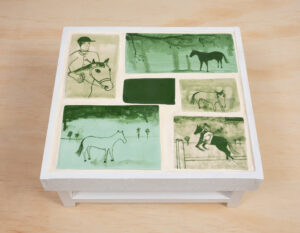
Small Table with Horses, by Noel McKenna, 2020
The August 1 series dates back to 1992. How did it start?
Well I’ve always had an interest in the horse racing industry mainly I grew up in Brisbane and my father used to like to go to the races all the time. I had an uncle who used to be a bookmaker. I think I was dragged down when I was about eight or nine with my father. It’s one of the few things we used to do together. We used to go to the races every Saturday. My other brothers weren’t as interested in it. I think the first day I went I backed a few winners, so I got hooked ever since.
I just thought it was a good concept or idea, for a series to hang together. I do love the horses. Just looking. Whenever I go to the races I go down to the stalls and have a look at them close up. I do just like looking at the horse. I like the whole atmosphere. And racing, when I first started going in the 60s in Brisbane, the atmosphere’s not quite the same now. You’d see a lot of old ladies dressed up in their hats in the tea rooms. It was very easy to start a conversation with older people down the races. Usually about ‘who do you like the in the next?’, stuff like that. But nowadays it tends to be more younger people go and they tend to just get drunk all day. So it’s not the same atmosphere so I don’t really like it as much. I was in Dublin a few years ago. It was the racing season and I went out to the Curragh (a racecourse). It’s been racing there since the mid 1700s, they say. It was a bit like you were in Brisbane in the 60s. It’s not a big track but everybody got dressed up and there was lots of kids and older people. It was a similar thing, you’d sit down and it would be very easy to start to talk to someone next to you. You’d see little boys about eight having a bet.
I saw one of their most famous trainers called Aidan O’Brien, he’s come to Australia few times to try and win the Melbourne Cup. He’s never won it. He’s the main trainer for Coolmore, an Irish operation. But this was a big day. Thousand Guineas day, which is a group one race. And he saddled up every horse which he had racing. Which is unusual. Every horse, before it went out, he combed the mane in the front of the head, I don’t know if it was a superstitious thing, but he was brushing every mane of the horse. The horses were just turned out beautifully. I like that little touch.
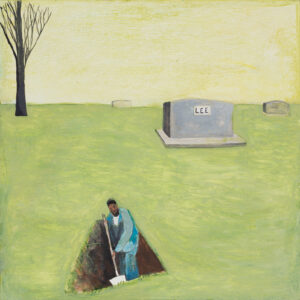
A Worker Digging Grave for Harper Lee February 2016 Monroeville Alabama, by Noel McKenna, 2020
Any ideas for which horse you’ll paint this August 1?
I haven’t got anything in mind, but I’ve got hundreds of photos of horses, so I’ll just go through them and sort of pick out one and it will sort of come to me on the day.
It has to be done on August 1?
Yeah, I like remain ethical like that. The purity of it, so to speak.
You took pix at Ron Quinton’s stables today?
Yeah, I took a lot of shots today.
You got Boss Lane.
Yep, and Magical Stance. There was a good one called Collage too, which I thought was a good name, being an artist. Collage was a beautiful horse, too, up close.
You don’t work from life?
I like to be in the quiet of the studio and the photographs sort of change reality a bit, too. You can work at a more laid back pace in the studio. You’re able to relax and concentrate.
I’ve known your work for years, first through the Big Things and the maps of Australia that you did.
The first map I did was actually the racetracks of Australia. That was hung in the Wynne Prize quite a while ago. That was just, you know, you just list every town that has a racetrack. Because I think Australia has more racetracks per capita than anywhere in the world.
Quite a lot of your work has a catalogue quality.
Yeah, I started doing those maps because I read somewhere where people go round galleries they spend about 30 seconds looking at a painting, no more than that. (But) every time I put those paintings up, people go up and they gravitate, and they spend a lot of time looking because you’re forced to look. So that’s sort of a device that I like doing because it makes people look at the work. And it works. It sort of has an accessibility thing to it. People identify with it.
Do you enjoy doing them?
You do learn things as you do them, so it’s quite good. The thing about doing them, you’re not making the same sort of aesthetic decisions when you do a normal painting. You put a word where it is because it’s where it is, you’re dictated to, it’s like a documentary. So you’re not making aesthetic decisions like other paintings. The map’s there so you’ve got to put the thing where it is.
You’re in this year’s Dobell Drawing Biennale at the Art Gallery of NSW.
Installing that next week. There’s one big work, remembering all the animals I’ve known in my life. I think the first animals I ever really got to know were stray cats. I grew up in West End in Brisbane. There was a lot of wild cats and I used to feed them and gradually tamed them all. I used to use all my money to buy pet food.
What did your mates say about that?
I don’t know if I told many. My parents didn’t like it.
Does that work look like a timeline?
Yeah. It’s in chronological order and it just kind of grew. I just started at one end. It’s a good thing to do, to remember your life. You do have to strain your mind sometimes. Some were pets. The first horse I saw was just at my school in West End. There used to be a big open paddock behind the school. They guy who owned the paddock used to keep this old grey horse on a really long rope tied to a tree. After school we used to go down and pat the horse. It was a very friendly horse. I’ve done a drawing of that from memory.
Is your greyhound Melman in the work about all the pets you’ve ever had?
I’d done all the work before Melman came along. But Max, the first greyhound, is in it. And Rosie. My first dog Stumpy is in it. He was a real character, part corgi Jack Russell. I think having pets teaches you things about life. You’ve got to devote some time to the pet. You’re not just thinking about yourself. They’re good company.
Elizabeth Fortescue, July 24, 2020

Vale Frank Watters
May 26th
The Sydney art community is mourning the death of Frank Watters whose unerring eye for art, his faith in his stable of artists and his inclusive, down to earth approach helped make Watters Gallery in East Sydney a cultural institution and an intellectual hub for 54 years until it closed in 2018.
Memories of Ria Murch
Apr 12th
Easter Sunday, 2020, during coronavirus lockdown.
It’s the perfect day to have driven north to visit Ria Murch at Avalon Beach.
A crystalline Autumn morning, with Summer not letting go and the leaves on my plane tree clinging on, still green and luscious.
Every inch of the road to Ria’s place carries me back not only to her, but to where I was born just a few houses down from her place. Over the Sydney Harbour Bridge, through manicured Mosman and down the sweep to the Spit Bridge. Through the Wakehurst Parkway with its wealth of ghost stories. And on to that glorious coast of wild, jutting headlands with profiles like ancient warriors, beautiful and cursed since that day when one of our schoolmates was swept off the rocks and his empty chair in our classroom would be a silent reminder of the ocean’s indifferent power.
Between Newport and Avalon you drive along the Bilgola Bends where the road snakes voluptuously along the coast. The bush tumbles thick and luxurious here, and lantana and salty air make your nostrils flare, wanting more. Ad hoc signs along the verges of the Bends are a local tradition. Welcome home Wazza. Happy 21st Macca. Cheerful reminders that you’re entering the Peninsula. The “insular peninsula” it’s been called. But it didn’t feel like that growing up there. It just felt like the most beautiful place in the world.
After the Bends, you drop down to the left and drive through the Avalon shops. Bill Mitchell’s corner deli still looks the same as it did in the 1970s, although the Italian fruit and vegetable shop in Avalon Parade is many decades gone. The owner Mr Taranto and his son Bob, always immaculately polite, wrapped everything in newspaper for Mum. Searl’s health food store was always a treat, with its glass-fronted wooden drawers full of cashews and pumpkin seeds.
Just a few minutes’ drive out of the village and you’re in Ria’s street. My old street. It’s just the same. The trees are tall and the modest little houses are enfolded in palm trees and bottlebrushes. There’s a famous stand of angophoras in an elbow of the road. Lots of kids lived in the street. In summer we danced about under the sprinkler on the grass out the front of our place. In winter, I remember, I loved seeing my distorted reflection in the concave back of the two-bar heater as Mum dried me down after a bath.
I must have been quite tiny when I first met Ria Murch and her artist husband Arthur. Their kids John and Michelle were too old for me to play with when we were all growing up, although I have since become good friends with Michelle. My parents were friends with the Murches, and Arthur (an Archibald Prize winner) painted my father Neville Fortescue for the 1955 Archibald Prize. The portrait still has pride of place in my home.
Arthur exerted a significant pull on me as a kid, given that he lived in the most extraordinary house. A typical Avalon fibro, it was as much studio as it was home. Half-finished sculptures peeked out of overgrown vines in the garden. A dead funnel web spider in a jar was among the mass of fascinating objects. There were paints and brushes, all in a kind of glorious disorder that immediately spoke to my heart of the wonderful things that were possible in life.
Arthur was always kind to me, teaching me a bit of drawing and, when I was a teenager, allowing me to come to his later studio in Artarmon where he made bread and we ate in happy companionship using newspaper as placemats. I remember Arthur asking whether I liked the sports or the crossword. When I was dropped off to the studio for my visit, a black dog was escaping out the front door with the loaf in his mouth. Arthur, in agitated pursuit, retrieved the bread and brushed it off. No problem. It was delicious.
Arthur died in 1989. By then I had been a journalist for over 10 years, and I wrote quite a few stories about Arthur’s life. More and more, however, my articles came to be about Ria and her quest to honour Arthur’s memory and his extraordinary life in art. She wrote a book about Arthur, and organised an retrospective exhibition of his work at the S.H. Ervin Gallery. She advocated for Arthur’s work, kept his legacy, organised his files, and championed his cause. Whatever she was doing, I always loved writing about it for the paper. (Michelle Murch has taken over the task of managing Arthur’s artistic legacy. Her website is arthurmurch.com)
Ria and I became fast friends. Lunch at her place was a treat, and was something my husband Stephen Gibbes and I always adored. Steve loved Ria, same as I did. You would park the car outside her house, and Ria would always be pottering about in the garden, waiting for you. Or she’d be in the kitchen, making something special. One day we had a gorgeous baked fish with vegetables, followed by baked apples and ice cream. Ria was never happy with her cooking. The fish was always “a bit dry”. But it wasn’t. She was a great cook, and lunch was always delicious.
Ria always had projects on the go. She shared them with you readily. Her epic struggles with her computer were laced with stories about keeping possums out of her roof and memories of Sali Herman’s peacocks straying into her garden and eating her flowers. Ria was never down-beat. Even after a nasty car accident in Avalon, she refused to dwell on her own situation. She always brushed aside her troubles, refusing to indulge them.
But she was a great listener, and loved hearing about what you were doing in your own life. What exhibitions had I seen? What did I think of such and such an artist? When I told her what I was writing about or planning to see, her words were always the same: “You go, girl”. Ria was always encouraging, having been a young journalist herself at one time, when she met Arthur.
She’d tell stories from her early years with Arthur, including how she fell in love with him when he was drawing the Russian ballet dancers at the Theatre Royal in Sydney. A young journalist, Ria was there to write about the touring ballet company. She had an immense knowledge of Australian art and, of course, of Arthur’s practice. It took me many years of listening to her, and reading about the things she told me, before I could get an understanding of what she was talking about. It was pure history. Gradually, I came to understand.
Nothing kept Ria down. She swam at Avalon Beach every morning. I remember her saying she couldn’t “stand” herself until she had done so. She was active in the Avalon community. In short, Ria was an inspiration to me and no doubt to many others. She died in her 90s in 2014. I attended the funeral service at Avalon Bowling Club, which was packed out with oldies, babies, and everyone in between. I made notes (journalists can’t help it) and I must find the shorthand scrawls where I recorded that important event.
It’s on days like this, when the fronds of the palm trees are gleaming in the sun out my window in the Inner West, that the Bilgola Bends beckon. A drive up north to see Ria would have been just wonderful.
Elizabeth Fortescue, April 12, 2020

